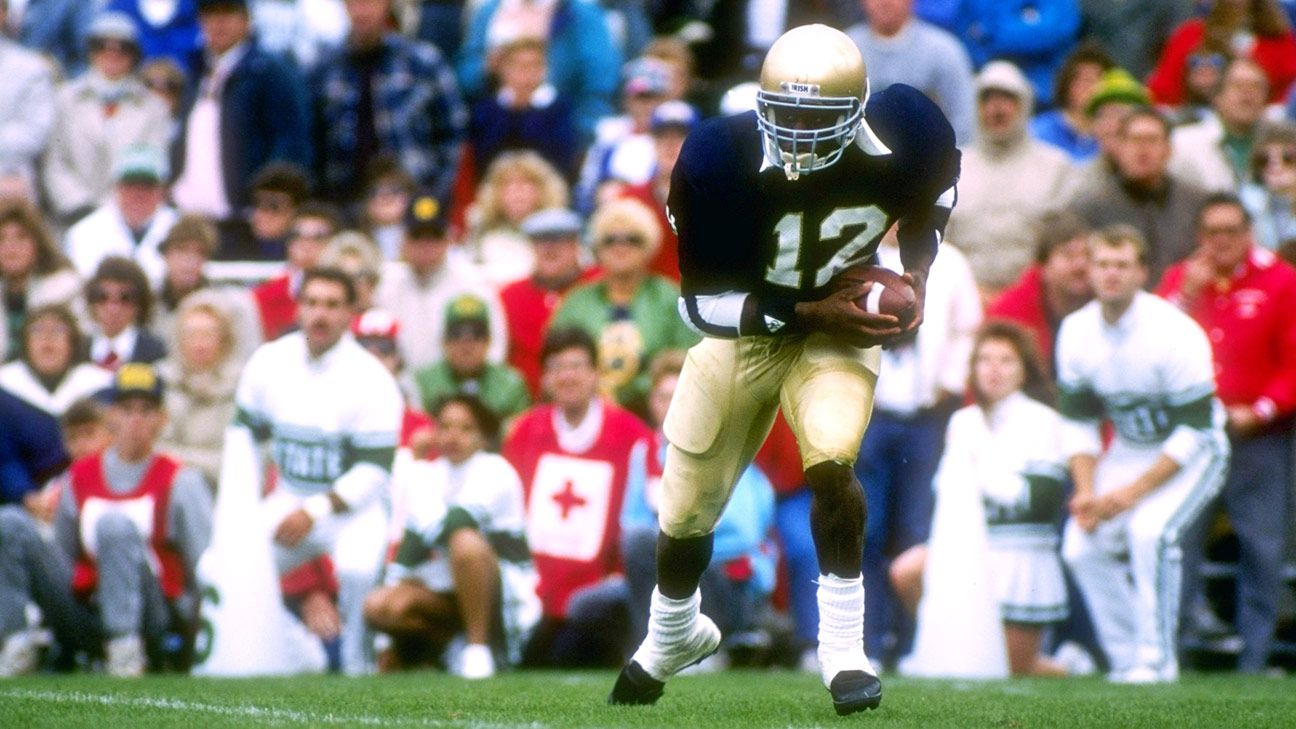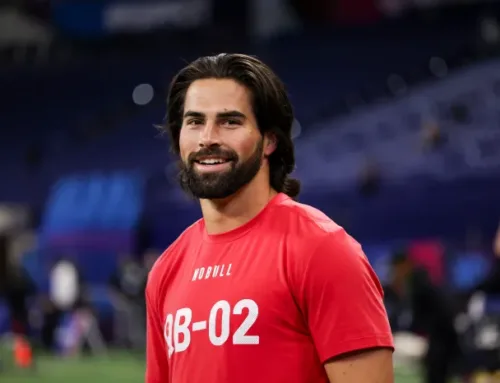I created a primer to this project which explains the way we’ll be ranking all 185 players. It will be a pyramid structure and as we ascend the players will get better and better. Follow along this off-season as we preach about all the wonderful talent that has played for Notre Dame.
Level 1, Wing 1
Level 1, Wing 2
Level 1, Wing 3
Today, we begin our ascent up the pyramid into level 2.
ICONS
National Champion
Consensus or Unanimous All-American
Major CFB Award
131. Frank Varrichione, OT, Natick, Massachusetts (1951-54)
One of the top players from the late Frank Leahy era. Varrichione excelled on both sides of the ball and truly developed once he switched from guard to tackle on offense. His best season came in 1953 during Leahy’s last campaign where Varrichione was given some All-American honors and was considered one of the best tackles in the country.
130. Jimmy Clausen, QB, Sherman Oaks, California (2007-09)
Clausen threw for the 2nd most pass attempts and completions in school history in just 35 career games. He holds the school-record by a wide margin for completions in a game with 37. He’s also the Notre Dame career leader in completions per game. Clausen’s 2009 junior season was the best completion percentage in school history until recently passed by Ian Book and also tied him for 1st in passer rating for a season in Irish history.
129. Frank Dancewicz, QB, Lynn, Massachusetts (1943-45)
Historians would say Dancewicz was as talented a quarterback as any in early Notre Dame history–he did go #1 overall in the NFL Draft. Yet, he took over as starter in 1944 when a lot of the talent in South Bend was overseas fighting during World War II. Dancewicz was good enough to finish 5th in the Heisman voting during his final season.
128. Knute Rockne, E, Chicago, Illinois (1910-13)
The man whose name sits atop the pyramid for his coaching has his playing days enshrined in the second level. Credited as one of the innovators of a passing attack as a receiver, he would earn All-American honors in 1913 before turning his attention towards coaching.
127. Clipper Smith, OG, Hartford, Connecticut (1925-27)
At the suggestion of player no. 128 above, Smith nearly quit football because he was deemed too small. And yet, he persevered as the captain of the 1927 team. For his effort, Smith was named a consensus All-American and was inducted into the College Football Hall of Fame in 1975.
126. Clem Crowe, E, Eden, New York (1923-25)
One of the “Seven Mules” who blocked for the Four Horsemen. He was the captain of the 1925 team, picked up All-American honors over his last 2 seasons, and was part of the school’s first-ever National Championship in 1924.
125. Gerry DiNardo, OG, Howard Beach, New York (1972-74)
A three-year starter on the offensive line over Ara Parseghian’s final 3 seasons. He won a National Title as a junior while blocking for the offense that gained most rushing yards in school history. DiNardo picked up consensus All-American honors as a senior.
124. Mark Bavaro, TE, Danvers, Massachusetts (1981-84)
Another player who built the Tight End U moniker but sat behind someone just above him in the Pyramid early in his career. Bavaro fought through injuries for most of his career–missing his sophomore season–but accumulated 55 receptions over his final 2 seasons. He picked up some All-American honors after the 1984 season with his 32 catches to that point the 4th most in a season for Notre Dame.
123. Jim White, OT, Bronx, New York (1942-43)
One of the more ferocious two-way players during the Leahy era. White only played 2 seasons for Notre Dame but claimed consensus All-American honors during the championship-winning 1943 campaign.
122. Nick Rassas, S, Wilmette, Illinois (1963-65)
A former walk-on who is often cited as one of the most misused athletes prior to Ara Parseghian being hired in 1964. A two-time starting safety as an upperclassman, Rassas shined on defense and special teams. He picked off 7 passes in his career and his 197 interception yards is the most ever in a season by an Irish player. He returned 3 punts for touchdowns in 1965 which helped him lead the nation in punt return yardage and still remains the school-record for punt return yards in a season. Rassas has the second-best punt return average in Notre Dame history and was awarded consensus All-American status as a senior.
121. Anthony Johnson, FB, South Bend, Indiana (1986-89)
Somewhat forgotten compared to other Holtz-era players, Johnson was considered one of the game’s best fullbacks and was remarkably tough and consistent over his 4-year career. His 32 career rushing touchdowns is tied for 4th in Notre Dame history and he was sneaky effective as a receiver (376 yards) as well.
120. Dave Huffman, C, Dallas, Texas (1975-78)
Huffman switched from tackle to center as a sophomore and spent 3 years as the Irish starter in the middle of the line. In 1977, he was given some All-American status as Notre Dame won the National Championship. As a senior, he became the first consensus All-American center for the Irish in nearly 30 years.
119. Tim Grunhard, OG, Burbank, Illinois (1986-89)
After not playing as a freshman, Grunhard made a few starts as a sophomore before starting every game over his final two seasons. A 1989 All-American, he was considered the rock of an offensive line that led the way to a National Championship during his junior year.
118. Bud Boeringer, C, St. Paul, Minnesota (1925-26)
One of Rockne’s top two-way players. Boeringer played on both lines and was a consensus All-American during his 1926 senior season. He just missed out on unanimous All-American honors in 1926.
117. Ricky Watters, RB, Harrisburg, Pennsylvania (1987-90)
An utility man who played both running back and flanker in Lou Holtz’ offense. Like many in this era he wasn’t able to show off his complete talents but did lead the 1988 championship team in receptions and punt returns, including a pair of scores in the latter area. He’s still 4th in career punt return average for the Irish and 10th in punt return yardage. Watters gained 1,370 yards on the ground as a junior and senior for a healthy 6.1 yards per carry average. In total, he gained 2,424 yards from scrimmage and 26 total touchdowns at Notre Dame.
116. Rip Miller, OT, Canton, Ohio (1922-24)
A lightning quick tackle and member of the famous “Seven Mules” that blocked for the Four Horsemen. Miller earned some All-American honors in 1924 while winning the school’s first championship. He was the first Mule to be inducted into the College Football Hall of Fame in 1966.
115. Andy Heck, OT, Fairfax, Virginia (1985-88)
Famously switched to offensive tackle from tight end and gained 30 pounds after his junior season to make the move. Heck surprised nearly everyone at Notre Dame with how dominant he would be at the new position, earning some All-American honors on the way to the 1988 National Championship.
114. Julius Jones, RB, Big Stone Gap, Virginia (1999-2001, 2003)
Suspended prior to his senior season, Jones took the year off and returned to finish an impressive career in South Bend. He remains 6th all-time in rushing attempts and his 262 yards against Pitt in 2003 is still the most yards ever in a game by an Irish tailback. Jones eclipsed the 200-yard mark in 3 separate games. His 2003 rushing total is tied for the 5th most in a single season and his career rushing is 6th most in Notre Dame history.
113. Art Hunter, OT, Akron, Ohio (1951-53)
Widely considered the most versatile lineman in school history. Hunter played 3 different spots on the line over his career and became a consensus All-American in 1953 as a senior at tackle. He was also a successful pass catcher on offense for Notre Dame.
112. John Yonakor, E, Boston, Massachusetts (1942-43)
Yonakor would certainly throw his hat in the ring as one of Notre Dame’s strongest players. Like many in this era, he excelled on both sides of the ball and was awarded consensus All-American honors after the 1943 season in which he was one of Leahy’s leaders on a National Championship squad. He never played his senior season after fighting in World War II and was drafted into the NFL upon his return.





Anthony Johnson was $$$.
^truth. Would have been even better in HS, and as a result even better prepared for the college game, if our coach wasn’t so terrible.
Would have loved to see Clausen getting 4 years under Kelly. His first season was the saddest I’ve ever felt for a football player. I remember a picture against Michigan where he’s getting sacked by 3 linemen with 2 others standing right there outside the pile. His O Line was so absurdly awful.
Julius Jones had a stretch early in his career, maybe his sophomore year, where he looked like he was going to go down as an ND kick returning legend. Eventually he started trying to turn every return into a big play and it killed his return average, but there was a stretch early on where I got so excited every time he got a chance to return. He was fun to watch.
#127 Clipper Smith. National Championship in 1927? That’s not a claimed championship year, the Houlgate system picked ND that year, but that’s one of the wonkiest ones.
True, fixed.
We are all wonks, so the NC should stand.
Would there be some way to draw out (Even crudely!) a visual of the pyramid? Or reference said visual more frequently? With all the wings and levels I’m having a tough time visualizing it and it would add value to be able to picture this. Love seeing the blast from the past, just trying to work where this is all building to.
I’ll have a recap post with everyone listed out together. I’d list the players out as we publish but the posts would become a giant wall of text that I wanted to avoid.
Don’t worry, Zibby will hold up the pyramid.